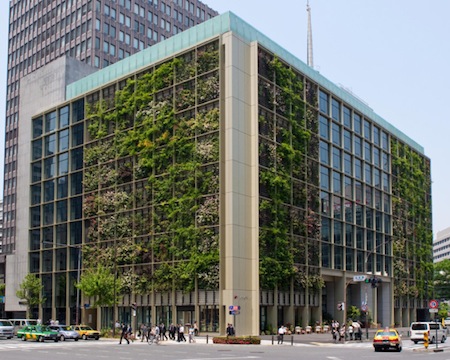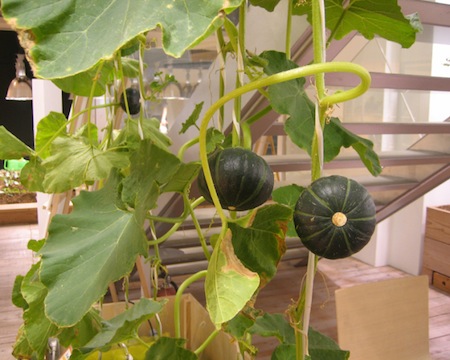Science Fiction
Dictionary
A B C D E F G H I J K L M N O P Q R S T U V W X Y Z
Pasona Office Building Is An Urban Farm

How much do you want to be green? At the offices of Pasona, a Tokyo agency, twenty percent of the space is devoted to growing fresh vegetables and other edible plants.

(Pasona building - livin' large)
... the urban farm—the largest in Japan, with a layout that architects around the world should be paying attention to—doesn’t just exist to produce fresh food for Pasona’s employees. With young Japanese citizens giving up agriculture for business in the city, Pasona and its architecture firm, Kono Designs, hope the lush surroundings will inspire urbanites, and give them a newfound appreciation for agriculture.The green areas use a combination of soil-based and hydroponic farming. One of the greatest challenges is balancing the climate needed for growing produce with temperatures that are more comfortable for humans. Some say this is the building’s greatest pitfall, with certain rooms repelling visitors. The main entrance, which sports a rice paddy, is a bit warmer, brighter, and moister than most people would prefer. Workers use a side entrance to avoid it.
I was going to use the Chlorella Plantation from Pohl and Kornbluth's 1952 novel The Space Merchants as an early example of an urban farm (which it is).
Update 27-Mar-2020:
End update.
However, take a look at this next photo.

(The plants are taking over!)
Apparently, some of the building spaces are a bit uncomfortable for business-suited humans, because the plants have taken over! I'm trying to think of examples (which I'm sure I've seen) that depict space ships at least partly taken over by plants.
Via QZ.
Scroll down for more stories in the same category. (Story submitted 8/19/2013)
Follow this kind of news @Technovelgy.| Email | RSS | Blog It | Stumble | del.icio.us | Digg | Reddit |
Would
you like to contribute a story tip?
It's easy:
Get the URL of the story, and the related sf author, and add
it here.
Comment/Join discussion ( 1 )
Related News Stories - (" Food ")
Holland Factory 3D Printing 500 Tons Of Steak Per Month
'...I don’t understand technical things — tell me, does it ever feel anything?" - Margaret St. Clair, 1955.
Robochef Robotic Food Prep
'No hand touched the food...' - Edgar Rice Burroughs, 1912.
Drone Deliveries Instead Of Waiters In Restaurants?
'It was a smooth ovoid floating a few inches from the floor...'- H. Beam Piper, 1962.
SliceIt! Why Not Teach Robots To Use Knives?
'One building now gushed forth smoke and another stench that was unmistakable.' - Anne McCaffrey, 1996.
Technovelgy (that's tech-novel-gee!) is devoted to the creative science inventions and ideas of sf authors. Look for the Invention Category that interests you, the Glossary, the Invention Timeline, or see what's New.
Science Fiction
Timeline
1600-1899
1900-1939
1940's 1950's
1960's 1970's
1980's 1990's
2000's 2010's
Current News
Proof Of Robothood - Not A Person
'Who are you people? - Show 'em.'
Dancing Robots Taught Dance Moves
'A clockwork figure would be the thing for you...'
Indonesian Clans Battle
'The observation vehicle was of that peculiar variety used in conveying a large number of people across rough terrain.'
The 'Last Mile' In China Crowded With Delivery Robots
Yes, it's a delivery robot. On wheels.
Tornyol Microdrone Kills Mosquitoes
'The real border was defended by... a swarm of quasi-independent aerostats.'
PLATO Spacecraft, Hunter Of Habitable Planets, Now Ready
'I ... set my automatic astronomical instruments to searching for a habitable planet.'
Factory Humanoid Robots Built By Humanoid Robots
'...haven't you a section of the factory where only robot labor is employed?'
iPhone Air Fulfils Jobs' Promise From 2007 - A Giant Screen!
'... oblongs were all over the floor and surfaces.'
ChatGPT Now Participates in Group Chats
'...the city was their laboratory in human psychology.'
iPhone Pocket All Sold Out!
'A long, strong, slender net...'
Did The Yautja Have These First?
What a marvel of ingenuity the little device was!
Jetson ONE Air Races Begin, Can Air Polo Be Far Behind?
'If you're one of those rarities who haven't attended a rocket-polo "carnage", let me tell you it's a colorful affair.'
Will Space Stations Have Large Interior Spaces Again?
'They filed clumsily into the battleroom, like children in a swimming pool for the first time, clinging to the handholds along the side.'
Mornine Sales Robot
'Robot-salesmen were everywhere, gesturing...'
Bipedal Robot Floats Gently While Walking
'a walking balloon proceeded with long strides of its aluminum legs...'
Musk Idea Of Cars Talking To Each Other Predicted 70 Years Ago
'My cars talk to one another.'
